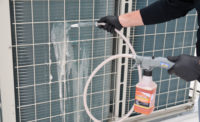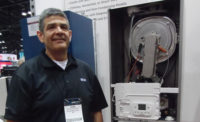There are doctors who work with systems made of flesh and bone, with blood and veins and nerves. And there are doctors who work with systems of metal and steel, with ducts and refrigerants and valves. Both are critical to the world in which we live. Both are viable careers. One is widely respected; the other, underappreciated yet just as in demand.
“I make high school guidance counselors cringe,” said Steve Gutsch, HVACR instructor at Chippewa Valley Technical College. “I look at the students and I say, No. 1, you don’t have to go to a four-year college, and No. 2, you don’t have to go to college right out of high school.”
With the HVAC industry facing a serious shortage of talent that’s only expected to grow in the next couple years, some colleges and contractors have come up with innovative ways to help college and trade school be as accessible as possible to all who may wish to enter the field.
“If we can fill the funnel in high school, then it’s going to help them keep going to deliver more to the field,” said Dave Chatmon, district manager at Lennox.
TEACHING ON DEMAND
Chris Essar is an HVAC instructor at Blackhawk Technical College in Rock County, Wisconsin, where the college has just debuted a new program called “teaching on demand,” now in its second semester.
“Students actually do their homework online, and then they come in when they have the availability to do their lab work,” he explained.
Teaching on demand came about when the college president decided to focus on helping people work around their schedules to get them into classes. The first two HVAC classes — Air-conditioning Fundamentals and Electric Fundamentals — are co-work classes: Students have to sit in class a certain amount of time. From there on, it’s on demand. Students do their homework and watch prerecorded lectures online. Then, they can come in and do the labs.
“We have checkoffs in the labs, to make sure they got the skill they needed ... they fill out the answers,” Essar said. “We read them. If you got it, move on; if you don’t, why don’t you go back and try to figure this out again.”
Essar said the biggest problem he has run into with teaching on demand is motivating his students, who are sometimes still learning time management. Classes are all one credit each, as opposed to more typical three-credit classes. Each credit takes about 20 hours in the lab, so they can get one credit done per week, as long as they stay on that pace. However, Essar has seen students sign up for too many credit hours or let their work slide.
“They have all this time at the beginning of the semester,” he said. “So then they start slacking at the beginning, then they get overwhelmed, and then they try to push at the end.”
Blackhawk Tech’s goal is to try to get new students who are currently working, according to Essar.
“If they need this class, they can audit that class,” he said. “Or if they’re in a career they want to get out of, they can take one or two credits, see if they like it, and keep moving forward that way.”
When Essar is talking to teachers and to parents of prospective HVAC students, he stresses learning skills that transfer to a variety of careers.
“There’s a lot of branches in the field,” he said. “When you learn your basics and when you know your heating and cooling systems, you’ve acquired a lot of skills that will help in the future doing other things. Troubleshooting skills, for example. I like to pitch it as having lots and lots of options; it’s the field with the most crossover. Controls, for example: Computer-based control stuff, all that stuff is just another branch of the field they can explore and go into. You can go into the electric field, plumbing, carpentry with the skills you learn. I always tell [parents], you’re paying for this particular program, but there’s so many other things you can actually do.”
EARN AS YOU GO
Ben Nusz teaches HVAC, construction trades, and renewable energy at Mid-State Technical College, a smaller technical college in the middle of Wisconsin. This year, the college started offering a 12-credit construction trades technical diploma, fully embedded into the HVAC program.
“It’s a building trades pre-apprenticeship sort of diploma,” he explained.
At Mid-State Technical College, a lot of students may get a degree in HVAC, work for a heating and plumbing company, and then go back and get their plumbing apprenticeship.
“So the question was, how do we take the things that we’ve trained and make sure they’re of value to them in these other pathways?” Nusz said.
All the trades — plumbing, HVAC, electrical, carpentry — have to take key courses that frequently overlap. Plumbers and HVAC students sit side by side learning things like blueprint reading, welding fundamentals, electricity, and fundamentals of construction.
“Now they can take these 12 credits — it’s basically everyone’s first semester — and then they can exit with a credential, a diploma,” he said. “We map out this entire pathway … chip away at your associate’s degree and now you’ve got your HVAC credential … or your renewable energy technician credential. Or, maybe you get your HVAC tech and you want to get your bachelor’s degree.”
Nusz calls these branches “career pathways,” and it changes the message that can be delivered to parents.
“It’s hard for me, in our technical colleges, to have a bunch of people with master’s degrees and Ph.D’s telling people not to go to college,” he said. “For me, that’s never the message. We don’t say ‘It’s this or this.’ Our pathway has allowed us to kind of change this message; you’re never doing something second-rate. You’re just doing this first. We say, ‘I want you to get that four-year degree, just start here.’ It’s saying, ‘We’ll take you there. We’re gonna give you a great trade along the way, and you’ll always eat.’”
The 12-credit pre-apprenticeship is offered two times during the year, and the second term runs January through April, so students can be out by the time the hiring season starts. Eighty percent of Mid-State Technical College’s students work part or full time while attending, so attending a full-time program isn’t feasible for them.
“We viewed this as a gap filler where they could then get employment but still work part time,” Nusz said. “If we’ve got really rigid parameters of when we offer our classes, it makes that impossible. We’ve tried to have all of our HVAC classes only on Monday and Tuesday. That frees them up three other days of the week. We try to make it work with reality.”
GIVE THEM THE TOOLS
Kendall Richards, president at All Comfort Services in Madison, Wisconsin, has been involved in recruiting new talent through the Lennox Impact Foundation. Giving out scholarships, which was the group’s prior focus, “has been kind of a failed attempt,” he said — not because they couldn’t raise the money, but because they could only help somewhere between six or eight students a year. Now, the foundation has started a reimbursement program, funding hand tools for those entering the industry.
Each dealer gets one reimbursement a year, “kind of with the message that ... maybe you should be doing this for all your new hires,” he said. He’s also involved with the Lennox dealer high school mentorship program, where dealers are asked to commit to talk on the phone with a high school student, meet with them for an interview for a paid internship, offer a ride along or job shadow, or talk at a local middle or high school.
“You can do the HVAC, you can do an associate’s, all these are options,” Richards said. “What you want for your kids and friends and everyone in life is to keep the doors open. That’s what that does. I don’t want it to be looked at as the better option, because it’s just an option.”
Richards’ background is in public accounting and law, yet he ended up in HVAC.
“I believe in academics, [but] not as much as I believe in real life,” he said. “What HVAC offers to kids is a phenomenal opportunity. They make six figures, six or seven years down the road ... if you’re talented, you’re hardworking, you educate yourself. It’s a great opportunity. It’s probably better than what 70 percent of the college students are making.”
Publication date: 5/13/2019
Want more HVAC industry news and information? Join The NEWS on Facebook, Twitter, and LinkedIn today!





Report Abusive Comment